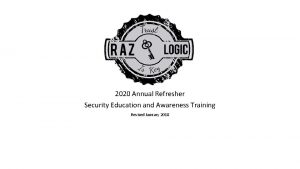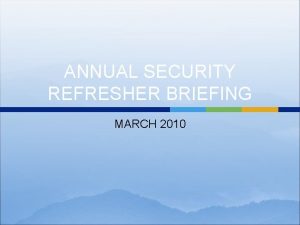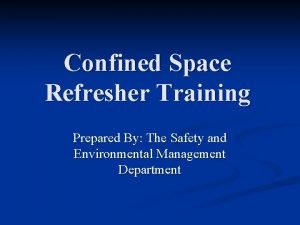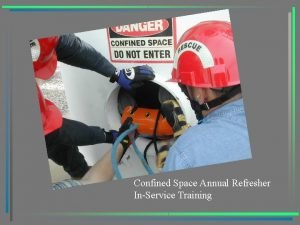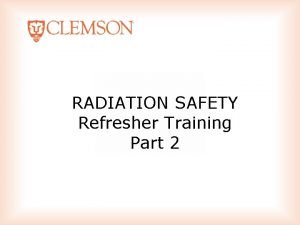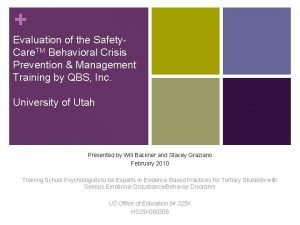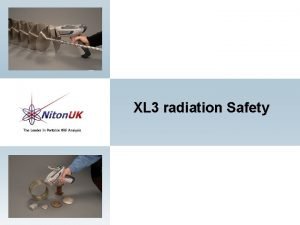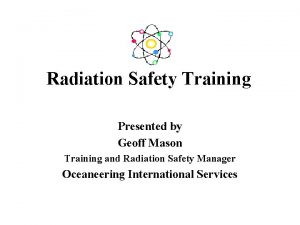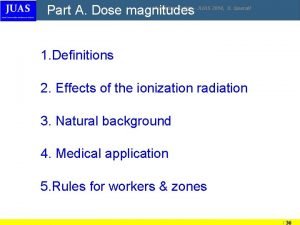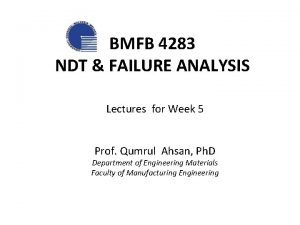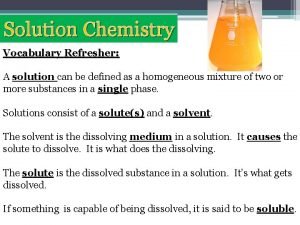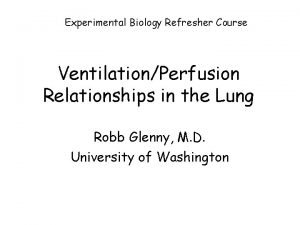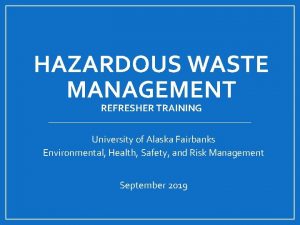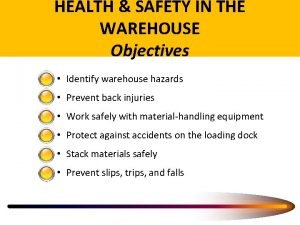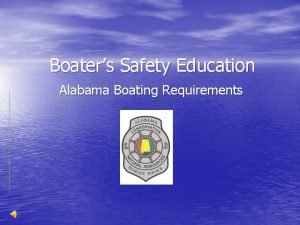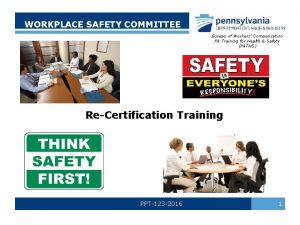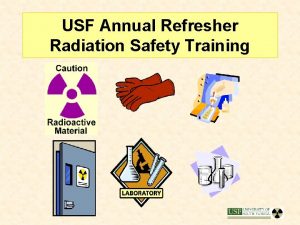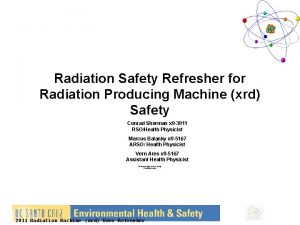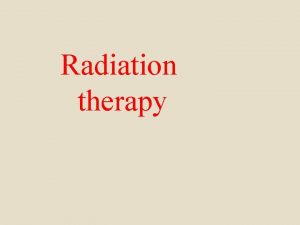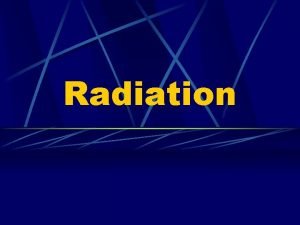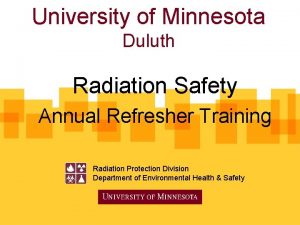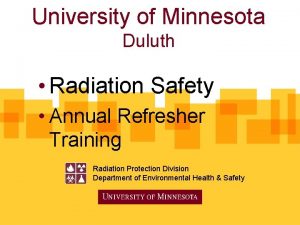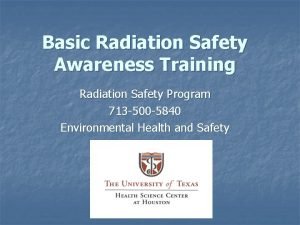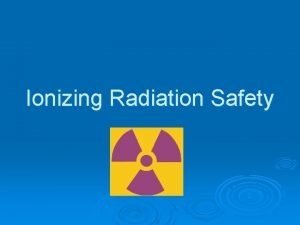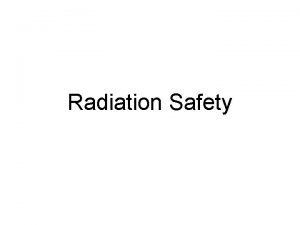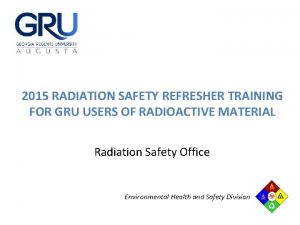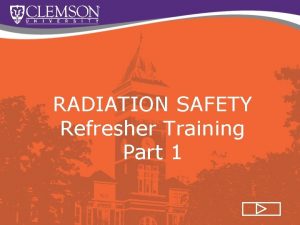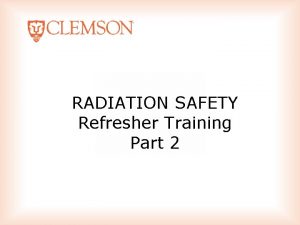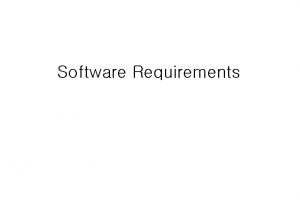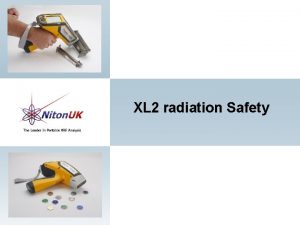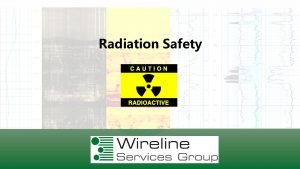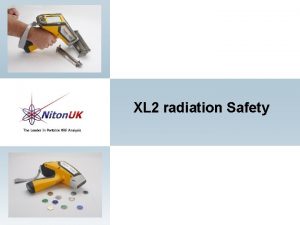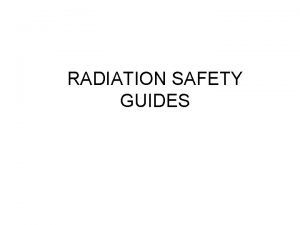Annual Refresher Training Radiation Safety Training Requirements In

























- Slides: 25

Annual Refresher Training Radiation Safety

Training Requirements In order to work with radioactive material you must be properly trained on the safe use and the minimization of risk associated with each isotopes. To keep your radiation worker status, you must have radiation safety refresher training once a year

Radiation is energy traveling through space, its most familiar form is sunshine Cosmic Radiation – high energy particles and photons from the sun and other celestial sources Terrestrial Radiation – radioactive materials occurring naturally in the earth’s crust Internal Radiation – from radioactive materials incorporated in the human body Inhaled Radiation – primarily radon and its progeny

Properties of Radiation Radioactivity is the natural property of certain nuclides to spontaneously emit energy, in form of ionizing radiation, in an attempt to become more stable. Ionizing radiation has the ability to remove electrons from atoms, creating ions. Ionization is the product of negatively charged free electrons and positively charged ionized atoms

Ionizing Radiation Particles Alpha: 2 protons & 2 neutrons Beta: electrons emitted from nucleus Neutrons: classified by energy Photons Gamma: no mass, no charge, speed of light

Radiation Units Rad (radiation absorption dose) is a measure of energy imparted to the medium Roentgen (R) is a measure of energy imparted to air, and the rem or dose equivalent takes into account effects from different types of ionizing radiation. Rem stands for “Roentgen Equivalent Man”, a unit of biological dose deposited in the body. The number of rems of radiation is equal to the number of rads absorbed multiplied by the relative biological effectiveness. One rem = 10 seiverts Curie (Ci) is the unit to measure a radioactivity, often expressed in smaller units like thousandths (m. Ci) or one millionth (u. Ci) n n n One curie(Ci) = 3. 7 x 10^10 dps (disintegrations per second) One millicurie(m. Ci) = 3. 7 x 10^7 dps = 1 x 10 -3 Ci One microcurie (µCi) = 3. 7 x 10^4 dps or 2. 22 106 dpm (1 x 10 -6 Ci) Becquerel (Bq) is a unit to measure a radioactivity, 1 transformation in one second, hence there are 3. 7 x 10^10 Bq in one curie

ALARA Primary goal of radiation safety is to avoid any unnecessary radiation exposure and to keep all exposure As Low As Reasonable Achievable Three mains ways to keep your doses ALARA is: Time Distance Shielding Note: Obtaining higher doses in order to get the experiment done quicker is NOT “reasonable”

Time, Distance, Shielding Time – Decrease exposure time decrease the radiation dose proportionately. Distance – The radiation dose rate varies with the inverse square of the distance of the source. Thus doubling distance from source will decrease the dose by factor of four Shielding Alpha is not an external hazard Beta stopped by ¼ inch of plexiglass, not lead Gamma stopped by high density materials such as lead

Preventing Internal Exposure INTERNAL RADIATION EXPOSURE CONTROL Follow the precautions below to minimize internal radiation exposure: Prevent absorption by changing your gloves frequently. Avoid touching your eyes, nose or mouth while conducting experiments. Monitor your work area with survey meter, wash your hands, and check your hands and lab coat with a survey meter. Prevent inhalation by using fume hood when you are using any volatile sources of radioactivity. Prevent ingestion by never eating, or drinking in the laboratory. Never store food in refrigerators or freezers or other areas designated for chemical or radioactive material storage.

Preventing Internal Exposure Use protective clothing. Always wear a laboratory coat, gloves, and closed-toe-shoes when working with unsealed radioactive materials Avoid spreading contamination. Do not touch telephones, light switches, faucet handles, or doorknobs with gloved hands. Look for contamination. Frequent monitoring of hands, surfaces, and equipment will alert you to contamination

Exposure Limits These limits are to ensure the risks from occupational radiation exposure levels are indistinguishable from other risks encountered from an average day of living Trunk of the body = 5 rem/ year Extremities = 50 rem/year Lens of the Eye = 15 rem/ year Organ dose = 50 rem/ year

Exposure Limits Declared Pregnant Worker The occupational dose level for a declared pregnant worker is limited to 500 mrem during the entire gestation period, or an average of 50 mrem per month. The pregnant worker can only be monitored if she declares her pregnancy in writing to the Radiation Safety Officer.

Survey Meters Check battery condition – needle should go to BAT TEST line on meter Turn large switch to the lowest scale – turn on audio switch. Note meter “background” reading in a location away from radiation source. Place probe (window face down) about ½ inch from surface being surveyed. Try not to let probe touch surfaces being checked. Survey work area by slowly moving probe over surfaces, listen to audible “clicks” from survey meter speaker.

Surveys Routine surveys of laboratory areas are the only means to ensure a safe and contamination free working environment Before and after each experiment, surveys of the radiation use area using Geiger counter or wipe tests Monthly wipe tests of use areas and Geiger survey of storage area must be recorded and kept in laboratory.

Wipe Samples With a cotton wafer, wipe an area of approximately 100 cm 2 (about the size of a U. S. dollar bill). You should wipe about 1% of the accessible surface area in “hot area”. In “clean” areas, take wipes of frequently used items or areas – calculators, phones, door knobs, high traffic floors, etc. Count the wafer with at least 3 ml of “safe” scintillation cocktail, along with a background sample consisting of a new/unused, damp, cotton wafer, in a liquid scintillation counter (set to “open” or “wide” window). The results should be reviewed and data taped on the appropriate lab schematic, sign and date the form.

Wipe Tests How do I determine if an area is “contaminated”? Note: Take gloves off before entering room. If the open-window count exceeds 200 cpm above background, you should recount the wipe vial before making it public to the other users in the room. If result is still above 200 cpm, you must decontaminate the area and perform another wipe test. A meter reading two times background in any part of your lab area that has no nearby radioactive material storage or radioactive waste storage needs to be decontaminated. If area cannot be cleaned after two attempts, contact Radiation Safety officer for assistance.

Half-life (T½) is the amount (T½) of time required for radioactive material to decrease by one half. Each radioisotope has a unique Half-life time period.

Common Radioactive Materials in Laboratories Phosphorus - 32 (P-32) Half life: 14. 29 days Pure beta emitter: Eavg = 0. 695 Me. V Emax = 1. 71 Me. V Hazard – External skin & Internal max range in air: 20 feet max range in lucite: . 02 inch Detection: Survey meter Phosphorus – 33 (P-33) Half life: 25. 3 days Pure beta emitter Hazard- Slight external max range in air: 20 feet max range in lucite: . 02 inch Detection: Survey meter Iron - 59 (Fe-59) Half life: 44. 5 days Low energy gamma & X-rays – Typical shielding needed (0. 5 mm of lead) Hazard – Internal organs Detection: Survey meter

Common Radioactive Materials in Laboratories Iodine-125 (I-125) Half Life: 60. 14 days Low energy gamma & X-rays – Typical shielding needed (0. 5 mm of lead) Hazard –External & Internal Detection: Survey meter Calcium – 45 (Ca-45) Half life: 162. 7 days Pure beta emitter Hazard- Whole body and bone max range in air: 20 feet max range in lucite: . 02 inch Cadmium-109 (Cd-109) Half Life: 462. 6 days Gamma & X-rays – Typical shielding needed (0. 5 mm of lead) Hazard –External & Internal Detection: Survey meter

Radiation Spill Scenario You’ve just spilled radioactive material on your lab coat and arm. Remove contaminated clothing and place them in a plastic bag Rinse exposed area thoroughly with soap and water, do not scrub Obtain medical attention if necessary Report the incident to your supervisor, and to the Radiation Safety Officer

Incidents/ Accident Response A Minor Incident is radioactive material has been spilled with no personnel contamination and your are confident in your ability to contain and clean the spill. Confine the spill and notify others in area Cover spill with absorbent paper Verify the isotope and estimate the activity involved Begin decontamination efforts, working from outer edge of the spill in to the center Notify your supervisor and the Radiation Safety Officer of the incident

Incidents/ Accident Response A Major incident is one where the radioactive material has been spilled and there is some type of personal contamination, high activity, or large area contamination, or you just aren’t confident that you can contain the material Notify others in the are and confine the spill and contaminated personnel Start decontamination procedures and notify Radiation Safety Officer as soon as possible Clean up and decontamination will be supervised by RSO.

Incidents/ Accident Response An Emergency is a situation where radioactive material has been spilled and the spill involves a fire, explosion, or personnel injury Evacuate the area and call 5111 or 911 In injury involved administer first aid Contact Radiation Safety Officer as soon as possible

Security Radioactive material must be secured from unauthorized persons. This mean that your radioactive material must be stored and used in a way that prevents unauthorized persons from gaining access to it. Principal investigators must determine the means used to assure security

The End You’re Done! See you next year. And don’t forget to take the mandatory quiz.
 Annual security refresher education
Annual security refresher education Annual security refresher
Annual security refresher Gdpr refresher training
Gdpr refresher training Confined space refresher training
Confined space refresher training Confined space refresher training
Confined space refresher training Refresher training example
Refresher training example Refresher training example
Refresher training example Safety care 2 person stability hold
Safety care 2 person stability hold Radiation safety
Radiation safety Radiation safety
Radiation safety Radiation safety
Radiation safety Tungsten inclusion in rt film
Tungsten inclusion in rt film Sql refresher
Sql refresher Chemistry molarity
Chemistry molarity Biology refresher
Biology refresher Java object oriented exercises
Java object oriented exercises Java programming refresher
Java programming refresher Ipv refresher course
Ipv refresher course Rt 130 refresher
Rt 130 refresher Ifr refresher
Ifr refresher Saeta refresher course 2021
Saeta refresher course 2021 Alaska hazmat training
Alaska hazmat training Biology refresher
Biology refresher Warehousing health and safety
Warehousing health and safety Alabama boat requirements
Alabama boat requirements Safety training for housekeeping staff ppt
Safety training for housekeeping staff ppt
